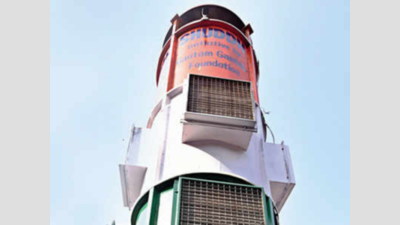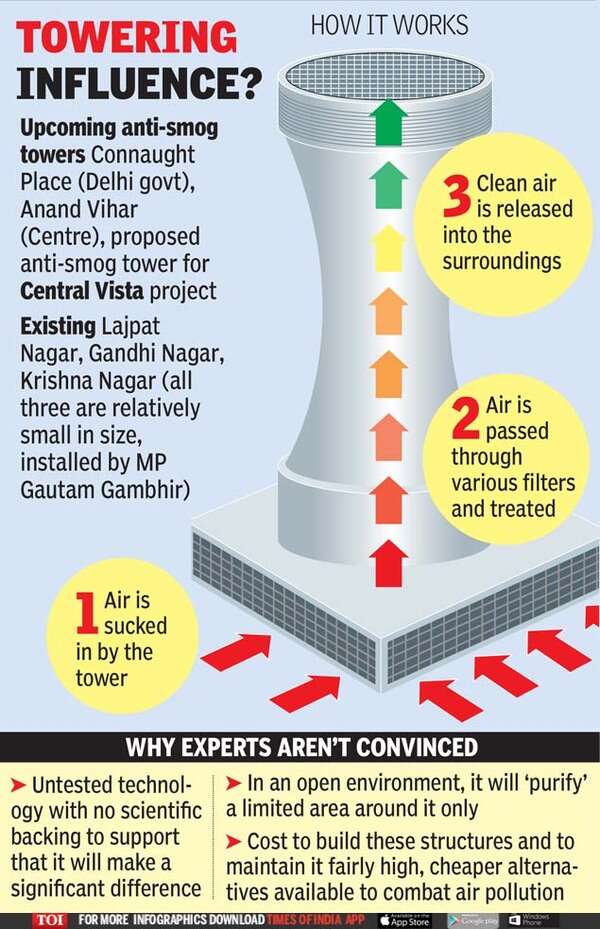- News
- City News
- delhi News
- Delhi: Fighting pollution with smog towers tall order
Trending
This story is from January 13, 2021
Delhi: Fighting pollution with smog towers tall order
After Anand Vihar and Connaught Place, anti-smog towers are likely to be installed as part of the Central Vista project. While Supreme Court has directed for anti-smog guns to be used during the construction phase, a tower will be needed for the vista once it is complete.

Smog tower in Lajpat Nagar
NEW DELHI: After Anand Vihar and Connaught Place, anti-smog towers are likely to be installed as part of the Central Vista project. While Supreme Court has directed for anti-smog guns to be used during the construction phase, a tower will be needed for the vista once it is complete.
Track the pollution level in your city
Though ambitious, the anti-smog tower concept is largely untested with no global studies to back its efficacy.Experts said while a pilot project could be launched to determine the impact of such towers, the cost to maintain and run them, coupled with the cost of “purifying” a relatively limited and open area, outweighed the benefits.

Tanushree Ganguly, programme associate, CEEW, said the funds being spent on these towers could be used elsewhere. Attention, in particular, was required towards thermal power plants. “Such unproven technologies shouldn’t be encouraged. The focus should instead be on ensuring that thermal power plants around Delhi comply with the emission norms notified in 2015. Also, the funds could be better utilised on an augmented and reliable transit system and scientific management of waste. Cutting down emissions is the only way to tackle air pollution,” she added.
Anumita Roy Chowdhury, executive director, research and advocacy, at Centre for Science and Environment said there was no data to support the fact that anti-smog towers could clean up outdoor ambient air. She stressed on the need for adapting better dust-control practices seen worldwide. “Detailed guidelines to control dust generated through construction and demolition and cheaper practices from abroad can be brought in,” she added.
To simulate the Rs 20 crore anti-smog tower at Connaught Place, CEEW carried out an experiment using an air purifier in a balcony as a “small-scale” version of the tower. The experiment measured readings within 12 feet of the device and found that while ambient air quality dropped by 20-25 micrograms per cubic metre (µg/m3), the impact was reduced when measured away from the flow of the air. Ambient air quality returned to normal as soon as the device was turned off.
CEEW’s analysis points towards the need for considerably altering the size of the device to make any significant impact to the surrounding air. Under normal circumstances, it was not likely to reduce to breathable limits from Delhi’s normal ambient PM2.5 readings of 120 µg/m3.
Karthik Ganesan, fellow at CEEW, who conducted the experiment, said PM2.5 readings that were 80-89 µg/m3 came down to 55-65 µg/m3 in the flow of the air. However, readings were as high as 75 µg/m3 away from the flow of air. “This means the impact was very short-lived. For sustained impact, people need to be in the vicinity of air purifiers for consistent periods. At a commercial space, where people dip in and out, the impact would be minimal,” he added.
Track the pollution level in your city
Though ambitious, the anti-smog tower concept is largely untested with no global studies to back its efficacy.Experts said while a pilot project could be launched to determine the impact of such towers, the cost to maintain and run them, coupled with the cost of “purifying” a relatively limited and open area, outweighed the benefits.

Currently, Delhi has three mini air-purifying towers installed by BJP MP Gautam Gambhir, but an analysis by Council on Energy, Environment and Water (CEEW) has found that 25 lakh such towers would be required to purify the city’s air.
Tanushree Ganguly, programme associate, CEEW, said the funds being spent on these towers could be used elsewhere. Attention, in particular, was required towards thermal power plants. “Such unproven technologies shouldn’t be encouraged. The focus should instead be on ensuring that thermal power plants around Delhi comply with the emission norms notified in 2015. Also, the funds could be better utilised on an augmented and reliable transit system and scientific management of waste. Cutting down emissions is the only way to tackle air pollution,” she added.
Anumita Roy Chowdhury, executive director, research and advocacy, at Centre for Science and Environment said there was no data to support the fact that anti-smog towers could clean up outdoor ambient air. She stressed on the need for adapting better dust-control practices seen worldwide. “Detailed guidelines to control dust generated through construction and demolition and cheaper practices from abroad can be brought in,” she added.
To simulate the Rs 20 crore anti-smog tower at Connaught Place, CEEW carried out an experiment using an air purifier in a balcony as a “small-scale” version of the tower. The experiment measured readings within 12 feet of the device and found that while ambient air quality dropped by 20-25 micrograms per cubic metre (µg/m3), the impact was reduced when measured away from the flow of the air. Ambient air quality returned to normal as soon as the device was turned off.
CEEW’s analysis points towards the need for considerably altering the size of the device to make any significant impact to the surrounding air. Under normal circumstances, it was not likely to reduce to breathable limits from Delhi’s normal ambient PM2.5 readings of 120 µg/m3.
Karthik Ganesan, fellow at CEEW, who conducted the experiment, said PM2.5 readings that were 80-89 µg/m3 came down to 55-65 µg/m3 in the flow of the air. However, readings were as high as 75 µg/m3 away from the flow of air. “This means the impact was very short-lived. For sustained impact, people need to be in the vicinity of air purifiers for consistent periods. At a commercial space, where people dip in and out, the impact would be minimal,” he added.
End of Article
FOLLOW US ON SOCIAL MEDIA










